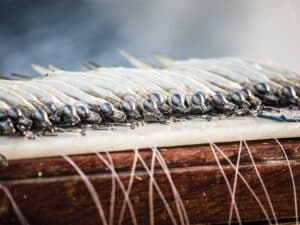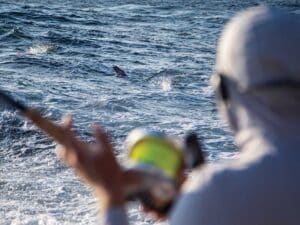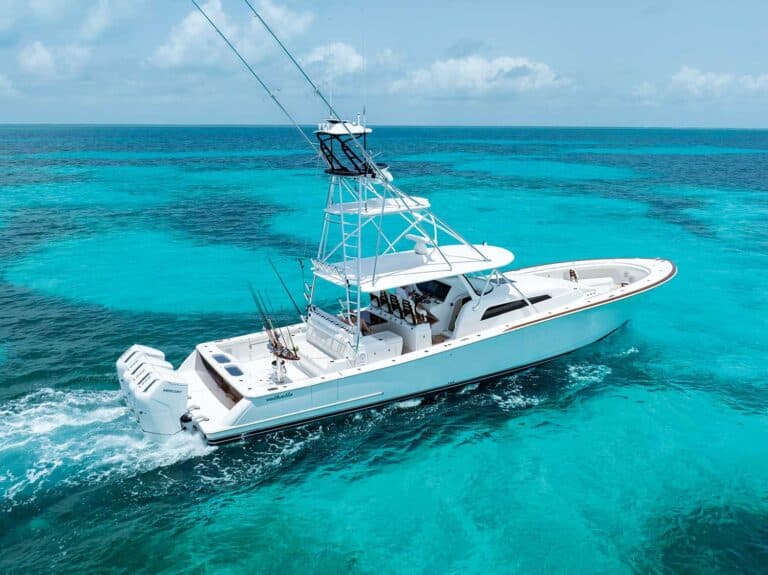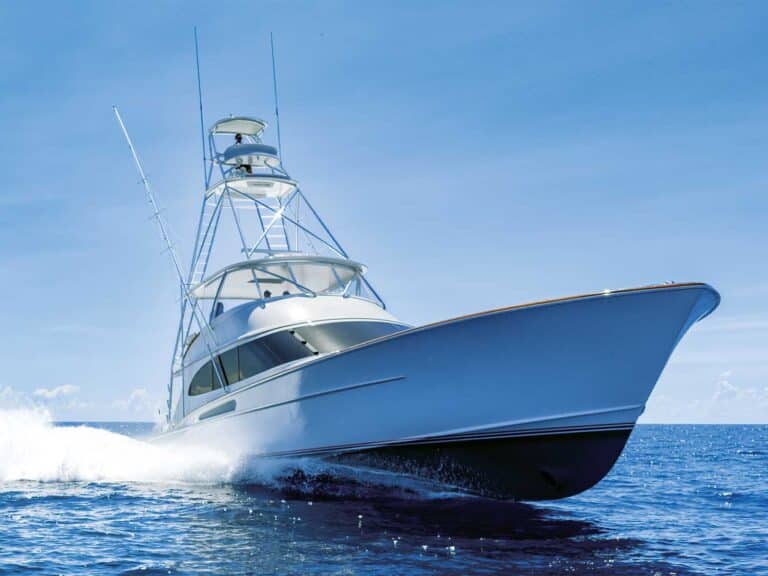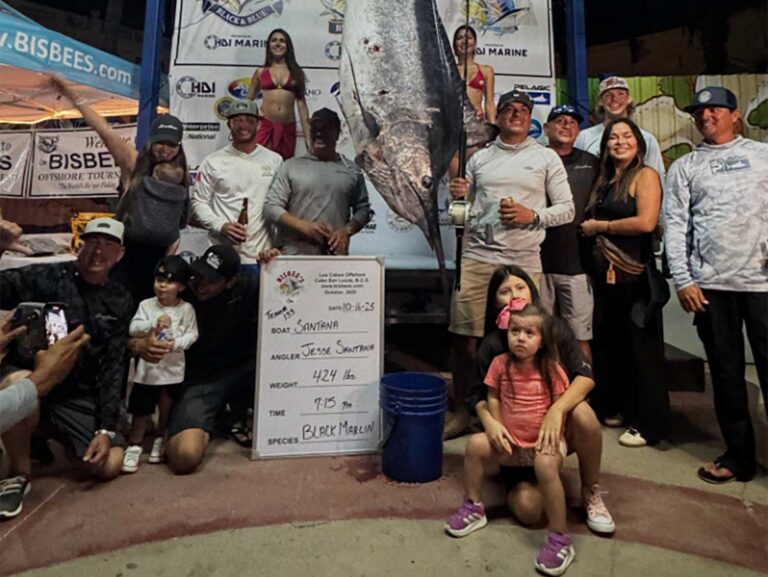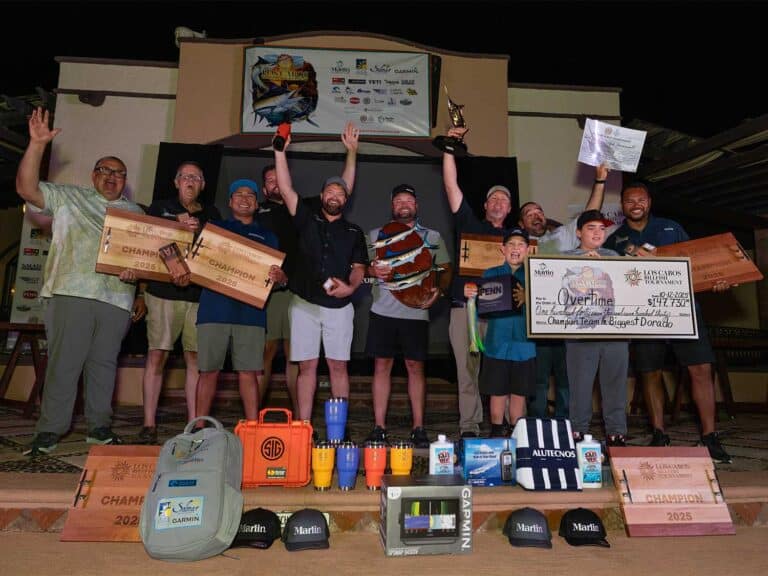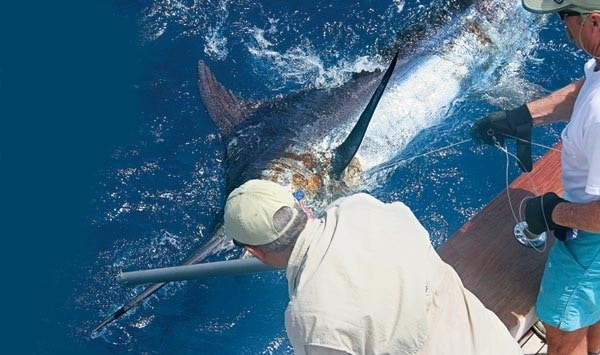
With more and more crews releasing fish without sticking them with either a tag or a gaff, the finely honed skill of wiring big fish is slowly fading away. The increase in the use of wind-on leaders — and rightfully so, by the way — didn’t help much either. When you add in the trepidation of grabbing hold of the leader on a fairly green 600-pound blue for the first time, without any real instruction, you can see why only the crazy and/or fearless step up to the pumps to give it go. But it really shouldn’t be that way.
For one thing, you don’t have to be large and strong to wire big fish! Just being healthy, agile and confident should enable you to get the maximum out of your big-game fishing experience by wiring that big fish yourself. Of course, you must learn the proper way to handle the leader and then practice it over and over until you feel confident in your ability. Hopefully, some of the pointers I’m sharing here will shorten the learning curve for beginners and improve the skills of those who already know the thrill of handling big fish at the boat.
What You’ll Need
I use the term “wiring” because in the good old days the leader material used most often was wire. Few teams still use wire leaders these days, and there is an abundance of different materials employed, but the technique remains the same for each. So for this article, I am using the term “wiring” for handling any type of leader on big fish.
First, you must start with proper equipment, and for this job that means getting, or making, a good pair of wiring gloves. Whichever way you go, your gloves must fit snugly, but not too tightly. They need to have good padding across the back of the hand and around the heel, the meaty portion of your hand under the pinky. The heel of your hand takes most of the pressure, so the padding there should be strong enough to protect your hand no matter how hard you pull.
I have used many different types of gloves through the years, and I now use the AFTCO Bluefever Wiremax glove because it offers protection where necessary yet is still flexible. But choosing wiring gloves can be a very personal thing, and you should pick a pair that you are comfortable with.
Another item of supreme importance is the type of footwear you choose. Many deckhands today prefer to wear flip-flops or sandals while fishing. Being from the old school, I still wear moccasin-type deck shoes. Regardless of the style of footwear you pick, it must come with an excellent nonskid sole. It doesn’t take much walking on the cement to ruin the nonskid, so the shoes that I fish with are never worn while I’m off the boat. I try to change into my fishing shoes once I leave the dock and switch back when I return. Sperry Topsider makes a nice nonskid sole, but I’m sure there are other fine alternatives out there as well.
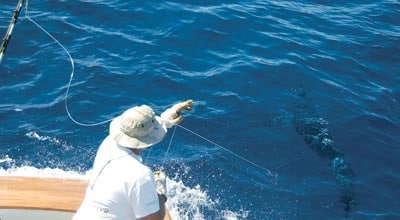
Still a Team
Even though the wireman is the only one directly connected to the fish, communication between the angler, captain and gaff man (or tag man) remains vitally important. The angler has to know that as soon as the wireman gets a wrap on the leader, he needs to back the drag off to at least half the amount of the fighting pressure. The angler does not need to back the drag into free-spool, but rather keep just enough pressure on the reel to prevent it from backlashing and be ready to go right back to the original fighting pressure if the wireman dumps the leader.
The angler also needs to know that the wireman will most likely have to dump the leader the first time he gets it. Since the fish is already familiar with the pressure the angler has been using, when you take your wraps and the pressure changes by four or five times, if the fish is going to jump, this is usually when it happens. All this should be discussed between the angler and wireman long before the fight begins. If the angler is inexperienced, the wireman might ask him to practice this a few times before the fish is on, showing the angler where to put the drag lever and where to go back to once the wireman dumps the leader.
It’s also a big plus if the captain driving the boat has some previous experience on the wire with big fish. I’ve been very fortunate to wire for great captains like Bark Garnsey, Peter B. Wright and Gary Stuve, who are all great wiremen in their own right. They anticipate what I am going to do by watching what moves the fish makes. I, in return, know what they are trying to do with the boat to help me wire the fish. In the thrill of the moment, a lot of communication, not spoken but understood, passes between the two. The trust and confidence that the wireman and captain must share cannot be overemphasized. The tag, or gaff, man needs to stand close enough to step in for the tag (gaff) whenever the opportunity arises, but not too close to restrict the movement of the wireman. The tag man must also watch the wireman’s back to help clear loose leader loops or tip wraps before they become catastrophic. When the fish comes alongside the boat, the tag man needs to step in behind the wireman – not in front. If the fish should make a move forward, the wireman needs room to move with the fish. And when moving with the fish, the wireman needs to keep as wide a stance as possible for stability.
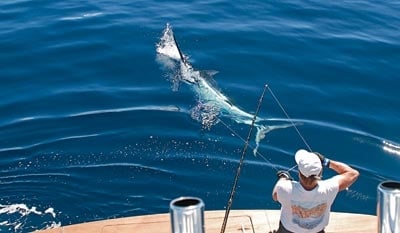
Grabbing the Leader
When most anglers fight a fish, the drag remains fairly constant and the fish gets used to the pressure. When using 80-pound line, most crews keep somewhere between 24 and 30 pounds of pressure on the fish for most of the fight. When the leader comes close enough for the wireman to reach out and grab, he’s usually stretched out a bit and bent over at the waist.
His first move should be to pinch the leader with one hand and try to move to the corner of the boat if he’s not already there. Sometimes the leader comes up straight over the stern, and that can’t be helped. Either way, as soon as you take the leader in your hand, you should move to whichever side of the boat the fish is closest to. This gets the fish out of the white water so you can see what it’s doing and anticipate its next move. This allows the captain to watch the fish as well so he can move the boat accordingly. At the same time, try not to put any more pressure than was being used by the angler, whether it is 30 pounds on 80-pound line or 50 on 130-pound. This should keep the fish from doing anything too exciting until you can get your back straight in an upright position to take your first wrap.
I like to take the first pinch in the port corner of the stern with my right hand so my first wraps will be on my left hand. And if possible, reverse the order in the starboard corner. I’ve found that the fish is probably going to make its first big move right after I get my first wraps. So if my first wraps are on the hand closest to the angler, when I dump the leader, it goes straight back to the tip of the rod without rubbing across my body. However, it’s important to practice enough to be equally proficient with either hand. You don’t want to enter a prizefight with one hand tied behind your back.
Now wrapping the leader around your hand may sound frightening to some, but when done properly, it should not be dangerous at all. You can’t pull much without wrapping the leader around your hand anyway since it will slide through your gloves. There are two ways to take that first all-important wrap, an overhand wrap and a backhand, or tuna, wrap. I much prefer the first wrap be a backhand one – the main reason being that you can get the wrap without lifting the head of the fish at all.
To get this wrap, you need to start by getting a pinch on the leader with one hand – when this happens, you need to be standing up with your back straight and your thighs against the covering board. Reach out with the other hand from under the leader so that the leader is up against the heel of your hand. Close your fingers across the top of the leader with a tight grip. Then take the hand that first pinched the leader and pull the leader across the heel and back of your other hand that you laid up against the line; at the same time, turn that hand’s palm up so the heel is closest to your body. This positions the leader on your hand exactly as the overhand wrap does but doesn’t move the fish’s head while getting the wrap.
For the second wrap, you have to use the overhand method. That means lifting the fish by pulling your hand up toward your waist with a bent elbow. Then roll your hand upward and over the leader so that the next wrap lies alongside the backhand one you already have on the glove. Try not to pull up past your waist. Your maximum strength comes from your core directly in front of your body and up to your waist. (A martial-arts expert told me once that there are similarities between wiring and hand-to-hand combat in that most of your strength comes from the same zone.)
If at any time during this entire process you feel that your wraps are not right or the fish starts pulling hard enough to straighten out your arms, just open your hand and let the leader come flying off. This is called dumping the leader. As long as your elbows are bent, you are pulling on the fish; as soon as your elbows straighten out, you are just holding on.
Yes, you can hold a lot more pressure than you can pull, but something is apt to break – or worse, you might go over the side. Anytime you dump the leader, you still have the fish on and can usually reach out and get another go at the wire fairly quickly. But if you hold on too long and break the leader, it’s over for that fish, and you might as well get back to fishing and try to get another one to save your reputation.
Practice, Practice, Practice
The backhand wrap will be a bit difficult to learn for people who have already learned to take overhand wraps, but I truly think it is worth learning and practicing over and over until it becomes a natural thing to do. If you are fortunate enough to get that real big fish to the boat but can’t lift it enough to get an overhand wrap, then you can almost always manage an initial backhand wrap. Once you have the double wrap and can pull the fish toward the boat, you can drop the pinched leader and start the backhand wrap on that hand. Keep the double wrap on one hand until you can get a double wrap on the second hand, in the same manner as you have already done. By doing this from one hand to the other, you bring the fish closer to the boat.
That last bit of distance on the wire can be done differently depending on what type of fish it is. If it is a big billfish, wahoo or dolphin, I try to keep its head in the water until someone places the tag or gaff in the fish. If the head breaks the surface, quite often these species will shake their heads or try to jump and dislodge the hook. Tuna just like to keep swimming down, so as soon as you can break their heads out of the water, they can’t dive on you anymore and are toast.
If you practice the proper technique on every fish you catch, even the tiny ones, when the big one finally comes along, you will feel much more confident in your abilities. One thing’s for certain: If you like big-game fishing now, just wait until you learn how to handle the leader on big fish – I truly believe you’ll grow to love the sport even more.
